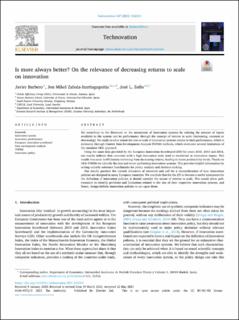| dc.contributor.author | Barbero, Javier | |
| dc.contributor.author | Zabala-Iturriagagoitia, Jon Mikel | |
| dc.contributor.author | Zofío, Jose Luis | |
| dc.date.accessioned | 2021-06-17T10:58:38Z | |
| dc.date.available | 2021-06-17T10:58:38Z | |
| dc.date.created | 2021-06-08T16:10:26Z | |
| dc.date.issued | 2021 | |
| dc.identifier.citation | Barbero, J., Zabala-Iturriagagoitia, J. M., & Zofío, J. L. (2021). Is more always better? On the relevance of decreasing returns to scale on innovation. Technovation, 107. | en_US |
| dc.identifier.issn | 0166-4972 | |
| dc.identifier.uri | https://hdl.handle.net/11250/2759946 | |
| dc.description.abstract | We contribute to the literature on the assessment of innovation systems by relating the amount of inputs available to the system and its performance through the concept of returns to scale (increasing, constant or decreasing). We study to what extent the size or scale of innovation systems relates to their performance, which is estimated through frontier Data Envelopment Analysis-TOPSIS methods, which overcome several limitations of the standard DEA approach.
Using the same data provided by the European Innovation Scoreboard (EIS) for years 2010, 2013 and 2016, our results indicate that countries with a high innovation scale tend to overinvest in innovation inputs. This results into scale inefficiencies stemming from decreasing returns, leading to lower productivity levels. Thanks to DEA-TOPSIS we identify the best and worst performing innovation systems. This provides helpful information by setting suitable reference benchmarks for policy analysis and decision-making.
Our results question the current allocation of resources and call for a reconsideration of how innovation policies are designed in many European countries. We conclude that for the EIS to become a useful instrument for the definition of innovation policies, it should consider the nature of returns to scale. This would allow policymakers to identify problems and limitations related to the size of their respective innovation systems, and hence, design holistic innovation policies to act upon them. | en_US |
| dc.language.iso | eng | en_US |
| dc.rights | Attribution-NonCommercial-NoDerivatives 4.0 Internasjonal | * |
| dc.rights.uri | http://creativecommons.org/licenses/by-nc-nd/4.0/deed.no | * |
| dc.title | Is more always better? On the relevance of decreasing returns to scale on innovation | en_US |
| dc.type | Journal article | en_US |
| dc.type | Peer reviewed | en_US |
| dc.description.version | publishedVersion | en_US |
| dc.rights.holder | © The Author(s) 2021. | en_US |
| dc.source.volume | 107 | en_US |
| dc.source.journal | Technovation | en_US |
| dc.identifier.doi | https://doi.org/10.1016/j.technovation.2021.102314 | |
| dc.identifier.cristin | 1914630 | |
| dc.source.articlenumber | 102314 | en_US |
| cristin.ispublished | true | |
| cristin.fulltext | original | |
| cristin.qualitycode | 2 | |

